戴炜栋主编英语语言学教程第三章课件 Morphology
语言学第三章chapter3 PPT
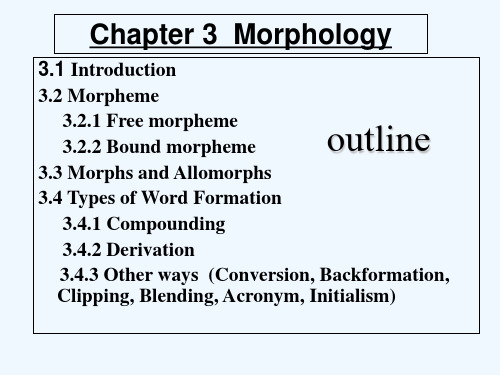
andbutbecauseifwhenonaboveinitthethat大家应该也有点累了稍作休息大家有疑问的可以询问和交流322boundmorpheme?boundmorphemesarethosethatcannotbeusedindependentlybuthavetobecombinedwithothermorphemeseitherfreeorboundtoformaword
▪ Prefixes are joined to the beginning of the root or stem. They can change the meaning or function of the word. Impossible, unbelievable, enrich
▪ Suffixes are joined to the end of the root or stem. They can also change the meaning or function of the word. hopeless, kindness
Differences between derivational morpheme and inflectional morpheme
语言学课件Chapter three Morphology 2
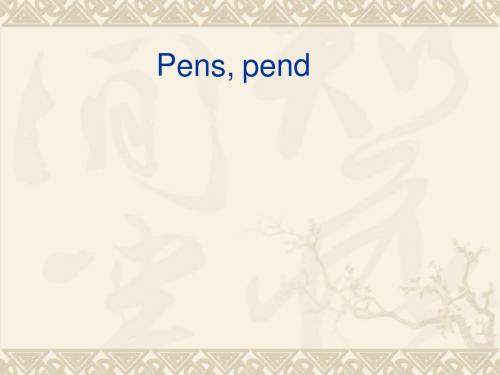
字根分布
“近取诸身,远取诸物” 近取诸身:人体各种组织器官,生理活动 远取诸物:自然界日月星辰,风雨雷电,山 水天地, 花草树木,鱼虫鸟兽
汉字的产生和发展同样是以“人”为中心的。
特别是从其部首就可看到首先记录的是人体 自身及人的衣食住行。文字学史上的不朽名 著《说文解字》540个部首中与人体相关的 就有197个,其中与“人“有关的83个,与 “脸、面、头等”相关的18个,与“目”有 关的10个,与“口”有关31个,与“手”相 关29个,与“足”相关26个。
英语词根分布
身体体验 2.自然体验 3.心理体验 4.社会体验
1.
身体体验
手,上肢
足,下肢 语言 组织器官及其它
手、上肢
足、下肢
语言
组织器官及其它
自然体验
位置方向变化
性质状态变化 数量变化 自然万物
位置方向变化
《现在汉语通用字表》7000个通用汉字中,以“口” 为部首(或偏旁)的字有300多个,以“手”为部 首(或偏旁)的字有250多个,以“心”为部首 (或偏旁)的字有190多个,以“女”为部首(或 偏旁)的字有130多个,以“言”为部首(或偏旁) 的字有150多个。汉字中表现人的身体以及人的衣 食住行的部首(或偏旁)所
自然万物
心理体验
情感
体验 认知体验
情感 体验
认知体验
社会体验
社会关系
生产生活及其它
社会关系
生产生活及其它
Word Formation
Compounding: armchair/rainbow Derivation: careless/ foolish Conversion: change of part of speech Backformation: television televise Clipping: refrigerator fridge Blending: motel Acronym: AIDS Initialization: CD, GDP, GNP
Chapter 3新编语言学教程 Morphology
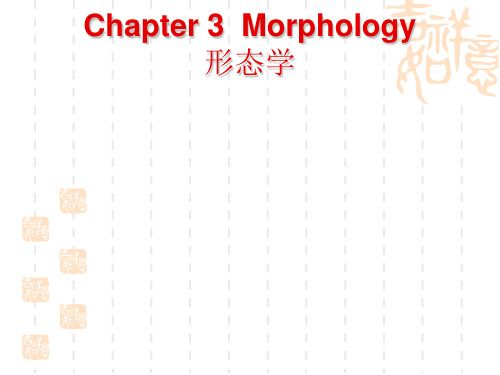
the classification of morphemes 1
A. free morpheme自由语素 Morphemes may occur alone or constitute words by themselves. All monomorphemeic单语素词 words are free morphemes.
Free morphemes can be divided into two categories: Lexical morphemes(词汇语素):ordinary nouns, verbs and adjectives which carry the content of messages we convey. E.g. book, desk Functional morphemes(功能语素):conjunctions, articles, prepositions and pronouns. E.g. if, when, because.
2. The smallest unit of morphology & the classification of morphemes
Morpheme(语素): A morpheme is a minimal unit of meaning or grammatical function. It cannot be divided without destroying or drastically altering the meaning, whether it is lexical or grammatical.
1.4 Definition of morphology P52
Morphology refers to the study of the internal structure of words and the rules by which words are formed.
英语语言学之Morphology PPT课件

授课题目 : morphology.
1
教学目标及基本要求:Teaching target and object
(1) Let students know what morphology is, and how the morphemes are combined into larger units for human communication.
16
Unbearable Watchful Soft-hearted
uneducated inspiring horsemanship
17
See the exercises 1 and 2 on page 82
18
1) un- + bear + -able 2) watch + -ful 3) person+ -ify (i) + -cation 4) un- + exception + -al + -ly 5) un- +educate +-(e)d 6) inspir(e) + -ing 7) soft + heart + -ed 8) horse + man + -ship
A word is “a minimum free form”, that is , the smallest form that can occur by itself.
8
The four characteristics of a word
A word is a sound or combination of sounds which we produce voluntarily with our vocal equipment.e.g. “we” [wi:]
戴炜栋英语语言学概论Chapter
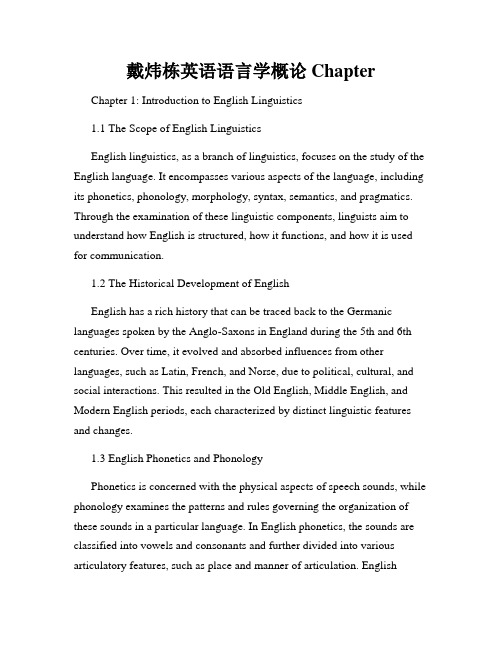
戴炜栋英语语言学概论ChapterChapter 1: Introduction to English Linguistics1.1 The Scope of English LinguisticsEnglish linguistics, as a branch of linguistics, focuses on the study of the English language. It encompasses various aspects of the language, including its phonetics, phonology, morphology, syntax, semantics, and pragmatics. Through the examination of these linguistic components, linguists aim to understand how English is structured, how it functions, and how it is used for communication.1.2 The Historical Development of EnglishEnglish has a rich history that can be traced back to the Germanic languages spoken by the Anglo-Saxons in England during the 5th and 6th centuries. Over time, it evolved and absorbed influences from other languages, such as Latin, French, and Norse, due to political, cultural, and social interactions. This resulted in the Old English, Middle English, and Modern English periods, each characterized by distinct linguistic features and changes.1.3 English Phonetics and PhonologyPhonetics is concerned with the physical aspects of speech sounds, while phonology examines the patterns and rules governing the organization of these sounds in a particular language. In English phonetics, the sounds are classified into vowels and consonants and further divided into various articulatory features, such as place and manner of articulation. Englishphonology, on the other hand, investigates sound patterns, such as stress, intonation, and phonotactics, which affect the pronunciation of words and sentences.1.4 English MorphologyMorphology is the study of word formation and structure. In English morphology, linguists analyze the internal structure of words and identify morphemes, which are the smallest meaningful units. English words can be divided into free morphemes, which can stand alone as single words, and bound morphemes, which can only be attached to other morphemes. Moreover, word formation processes, such as affixation, compounding, and derivation, are examined to understand how new words are created in English.1.5 English SyntaxSyntax investigates the rules and principles governing the arrangementof words to form grammatically correct sentences. In English syntax, linguists analyze sentence structures, constituents, and grammatical relationships, such as subject-verb agreement, word order, and sentence types (declarative, interrogative, imperative, etc.). The analysis of syntactic structures allows us to comprehend how sentences are constructed and how different meanings are conveyed through sentence formation.1.6 English SemanticsSemantics studies the meaning of linguistic expressions, including words, phrases, and sentences. In English semantics, linguists explore how meaning is conveyed through lexical and grammatical devices, such as synonyms,antonyms, hyponyms, and collocations. Additionally, pragmatic aspects, such as implicature, speech acts, and context, play a crucial role in understanding the intended meaning of utterances in different communicative situations.1.7 English PragmaticsPragmatics involves the study of how context influences the interpretation and use of language. In English pragmatics, linguists examine various pragmatic phenomena, such as politeness strategies, discourse analysis, speech acts, and conversational implicature. Understanding pragmatics helps us interpret utterances and understand the intended meanings beyond the literal level, as well as navigate the social and cultural aspects of communication.1.8 ConclusionEnglish linguistics provides us with a comprehensive understanding of the English language's structure, function, and usage. Through the examination of its phonetics, phonology, morphology, syntax, semantics, and pragmatics, linguists gain valuable insights into the complexities of English and its role as a global language. By continuing to explore and analyze these linguistic aspects, we can further enhance our knowledge and proficiency in English communication.。
Chapter 3. Morphology 简明英语语言学 戴炜栋

Roots(词根) A root is the base form of a word which cannot be further analyzed without total loss of identity. That means it is that part of the word left when all the affixes are removed. E.g international disheartened
2.2 Types of morphemes Free morpheme(自由词素) A free morpheme is one that may constitute a word by itself. E.g bed, tree, sing, dance Bound morpheme(粘附词素) A bound morpheme is one that cannot appear alone. It may appear with at least one other morpheme. E.g “-s” in “dogs” “-al” in “national”
Words have Structure The simplest way to form new words out of old elements is by compounding V N V baby sit N N N church yard
chapter_3__morphology ppt课件

ppt课件
14
Auxiliaries
• Negation
• I can’t come. I wantn’t come.
• Inversion
• Is he coming? Keeps he coming?
词素——最小的意义单位
ppt课件
19
• A morpheme is the smallest meaningful grammatical unit thatis composed of three elemments denoting sound, meaning and form---respectively phoneme, lexeme and grapheme.
ppt课件
17
• A grammatical unit: sentence clause phrase word morpheme
ppt课件
it of meaning
• It is the smallest/minimal unit in terms of relationship between expression and content, a unit which cannot be further divided without destroying or drastically altering the meaning, whether lexical or grammatical.
m
ppt课件
22
The morpheme (语/词素) is to the morph (形素) what a phoneme(音位) is to a phone (音素).
戴炜栋《新编简明英语语言学教程》课件讲义

Chapter 1. Introduction
1. What is language?
Language can mean
o what a person says (e.g. bad language, expressions)
o the way of speaking or writing (e.g. Shakespeare’s language, Luxun’s language)
linguistics; o To understand the applications of the
linguistic theories, especially in the fields of language teaching & learning (SLA or TEFL), cross-cultural communication……; o To prepare for the future research work.
Hall’s definition (1968)
o Language is “the institution whereby humans communicate and interact with each other by means of habitually used oral-auditory arbitrary symbols.”
Language can be generally defined as
a system of arbitrary vocal symbols used for human communication.
Language is a system
o Systematic---- rule-governed, elements in it are arranged according to certain rules; can’t be combined at will. e.g. *bkli, *I apple eat.
戴炜栋主编英语语言学教程第三章课件 Morphology

Phoneme, morpheme and allomorph
Phoneme /p/ [p] Morpheme
{-s} plural marker of nouns Allomorphs:
[s] [z] [is]
3.4 Analyzing word structure
Root: the base form of a word that cannot be further analyzed without total loss of
Stem
A stem is a form to which affixes can be attached.
Thus, in this usage, the English word friendships contains the stem friend, to which the derivational suffix -ship is attached to form a new stem friendship, to which the inflectional suffix -s is attached.
-ful, -er, -ish, -ness, -able, -tive, ion, etc.
Prefixes modify the meaning of the stem, but they usually do not change the part of speech of the original word.
boy, girl, table, nation.
Bound morpheme: the morpheme that cannot occur alone as a word, e.g "s" in"dogs", "al" in "national" "dis" in disclosed",
chapter_3__morphology ppt课件

ppt课件
探讨词的意义及语义关系,阐述词汇变化 过程,涉及相关的词典知识。学习词汇学 就是学习有关词汇的系统知识, 了解词汇
的现状及其历史演变过程,能够对现代词 汇发展中出现的各种现象做出分析和解释。 ----《英语词汇学》,汪榕培
ppt课件
3
• Lexicology, a branch of linguistics, is the study of lexemes or vocabulary of a langauge, including nature, history, formation, (morphological) structure, meaning, collocation, uses and usages of words.
C
L Close class words
A
S
Grammatical/
----- H. Jackson & E. Z. Amvela, Words, Meaning and Vocabulary: An Introduction to Modern English Lexiocology, 2000
ppt课件
2
• 词汇学是研究词汇背后的规律性和系统性 以及词汇的结构关系和类别的科学,它运 用语言学的相关理论,研究语言中有关词 汇的问题, 讨论词的形态结构及构成方式,
• The essential difference is a matter of emphasis: morpholgy is word grammar with meaning, while lexicology is word semantics with form.
戴炜栋语言学教程讲义
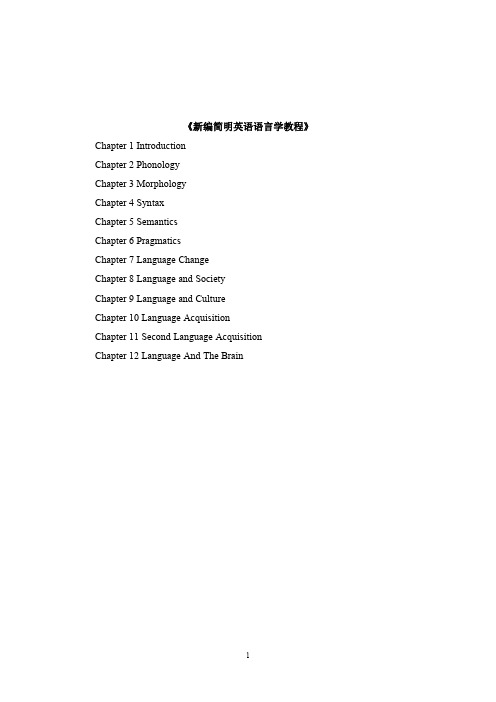
《新编简明英语语言学教程》Chapter1IntroductionChapter2PhonologyChapter3MorphologyChapter4SyntaxChapter5SemanticsChapter6PragmaticsChapter7Language ChangeChapter8Language and SocietyChapter9Language and CultureChapter10Language AcquisitionChapter11Second Language Acquisition Chapter12Language And The BrainChapter1Introduction考情分析本章分为两个部分,第一部分介绍了什么是语言学,主要是对语言学的定义、语言学的研究范围以及语言学中6对重要的概念进行了区分。
第二部分介绍了什么是语言,主要对语言的属性,语言的区别性特征以及语言的功能进行了详细的介绍。
本章常出的题型有填空题、翻译术语、术语解释、简答题以及论述题,大家在复习的时候尤其要注意以下重点内容:◆语言学中6对重要的概念区分Some important distinctions in linguistics(6)◆语言的识别性特征Design features of language(5)◆语言的功能Functions of languageContents1.1What is linguistics?1.1.1Definition1.1.2The scope of linguistics1.1.3Some important distinctions in linguistics(6)Prescriptive规定性vs.Descriptive描写性Synchronic共时性vs.Diachronic历时性Speech口语and Writing书面语Langue语言and Parole言语---Saussure索绪尔Competence语言能力and Performance语言运用---Chomsky乔姆斯基Traditional grammar传统语法and modern linguistics现代语言学1.2What is language?1.2.1Definitions1.2.2Design features of language(5)Arbitrariness任意性Productivity/Creativity创造性Duality/Double Articulation二重性Displacement移位性Cultural transmission文化传递性1.2.3Functions of languageVersion1Social function社会功能Expressive function表达功能Descriptive function描述功能Version2Code语码---Metalinguistic元语言功能Jakobson Addressee受话者---Conative意动功能Context语境---Referential所指功能Message信息----Poetic诗学功能Contact接触---Phatic communication寒暄功能Addresser说话者---Emotive情感功能Version3ideational概念功能Halliday interpersonal人际功能textual functions语篇功能Chapter1Introduction1.1What is linguistics?1.1.1DefinitionLinguistics is generally defined as the scientific study of language.◆It studies not any particular language,but it studies languages in general.◆It is a scientific study because it is based on the systematic investigation of linguisticdata,conducted with reference to some general theory of language structure.Q1.How do you interpret the following definition of linguistics:Linguistics is the scientific study of language?1.1.2The scope of linguisticsThe study of language as a whole is often called general linguistics.普通语言学Phonetics(语音学)——The study of sounds used in linguistic communication led to the establishment of phonetics.Phonology(音系学)——It studies how sounds are put together and used to convey meaning in communication.Morphology(形态学)——The study of the way in which these symbols are arranged and combined to form words has constituted the branch of study.Syntax(句法学)—It studies the rules governing the combination of words that form grammatically permissible sentences in languages.Semantics(语义学)——It studies the meaning conveyed.Pragmatics(语用学)——It studies the meaning in the context of language use.跨学科分支Sociolinguistics(社会语言学):The studies of all these social aspects of language and its relation with society.Psycholinguistics(心理语言学):The study of language to psychology.Applied linguistics(应用语言学)【2017术语解释104points】:The study of such applications is generally known as applied linguitics.In a narrow sense,it refers to the application of linguistic theories and principles to language teaching,especially the teaching of foreign andsecond languages.1.1.3Some important distinctions in linguistics(1)Prescriptive vs descriptive【2013简答题2710points】①Prescriptive(规定性)The linguistic study aims to lay down rules for“correct and standard”behavior in using language,i.e.to tell people what they should say and what they should not say.(为语言的“正确和规范”规定一系列的语法规则,例如告诉人们应该说什么和不应该说什么)【2015翻译术语18prescriptive grammar规约性语法】②Descriptive(描写性)The linguistic study aims to describe and analyze the language people actually use.(对人们使用的语言进行客观描述与分析)For example,traditional grammar is prescriptive because it aims to set models for people to follow.While modern linguistics is mostly descriptive because it is supposed to be scientific and objective and its task is to describe the language people actually use.Q2.What are the differences between the descriptive and the prescriptive approaches?(2)synchronic vs diachronic①Synchronic(共时性)——the description of a language at some point of time in history.(对某个时间点上的语言状态的描述)②Diachronic(历时性)——the description of a language as it change through time.It is a historical study;it studies the historical development of language over a period of time.【2011填空1】【2016术语解释216points】(它是对语言随着时间的变化而变化的描述,是一种历史性的研究,研究的是语言在某一段时间内的历史发展)Q4.Is modern linguistics mainly synchronic or diachronic?why?a.In modern linguistics,a synchronic approach seems to enjoy priority over a diachronic one. Because it is believed that unless the various states of a language in different historical periods are successfully studied,it would be difficult to describe the changes that have taken place in its historical development.现代语言学中,共时性研究比历时性研究更重要。
戴炜栋英语语言学概论Chapter 3

4.1) 2)来自3)4)the third person singular the past tense the present perfect the present progressive
5. a) inflection b) derivation c) inflection d) derivation 6. Omitted.
Good luck!
Thank you for your attention!
2. Suffix: -ly Meaning: functional Stem type: added to adjectives Examples: freely, quickly Suffix: -able Meaning: something can be done or is possible Stem type: added to verbs Examples: acceptable, respectable
For example:
One morpheme Two morphemes Three morphemes Four morphemes Practice: Exercise 1 (p40)
desire desire + able desire + able + ity un + desire + able + ity
Revision Exercises (p40)
1. a) micro + film; b) be + draggle + ed c) announce + ment d) pre + digest + ion e) tele + communicate + ion f) fore + father g) psycho + physics h) mechan + ist
chapter 3 Morphology 英语专业语言学PPT

Derivational and inflectional morphemes (p.55)
Some derivational morphemes change the grammatical category of words (or grammatical class of words) and others
➢ the smallest unit in terms of relationship between expression and content,
➢ a unit which cannot be divided without destroying or drastically altering the meaning, whether it is lexical or grammatical.
When the root of the word is a free morpheme, we say the word has a free root, such as e.g. hopeful, interpersonal
When it is a bound morpheme, we say the word has a bound root, such as e.g. precede, receive, submit, retain, recur
The identification of words
(2) Relative uninterruptibility(相对的不可 隔 断 性 ): new elements are not to be inserted into a word even when there are several parts in the word. (i.e. outlaws, touch-me-not)
《新编简明英语语言学教程》学习手册(打印版),戴炜栋

《语言学概论》学习指导第一章III. Answer the following questions briefly.1.What features does human language have, which can not be foundin animal communication system?2.Why is spoken language given priority to written language inmodern linguistics?3.What are the features of modern linguistics?第二章语音学一、导读2.1 语音研究人类交际包括两种形式:语言交际(linguistic communication) 和非语言交际(paralinguistic communication)。
非语言交际包括手势、表情、眼神或图表等。
语言交际包括口语(spoken language)和书面语(written language)。
在多数情况下,人们主要是通过口语进行交际。
口语交际的媒介是语音(speech sounds),也就是说人们通过声道(vocal track)发出的音来表达意义。
这种对语音的研究被叫做语音学(phonetics)。
口语交际是一个复杂的过程。
可以想象,当人们交际时,语音首先被说话者发出,然后,它在空气中被传递并被听话者接收。
也就是说,口语交际包括三个基本步骤:语音的发出→语音在空气中的传导→语音的接收。
根据这三个步骤, 语音研究也自然地分成三个主要研究领域。
对第一个步骤的研究是发声语音学(articulatory phonetics),研究语音的产生。
对第二个步骤的研究是声学语音学(acoustic phonetics),研究语音的物理特征。
对第三个步骤的研究是听觉语音学(auditory phonetics),研究和语音感知有关的内容。
课件3._morphology

前缀和后缀
前缀和后缀都是从单词 开头或结尾添加的符号。
中缀
中缀是添加在单词内部 的符号,一般用于词汇 的缩略或组合。
复合词
复合词由两个或多个单 词组成而成,例如“公共 汽车”、“黑板报”。
形态框架
形态框架的定义
形态框架是形态学研究中对 单词内部构词规则的一种体 系化总结。
形态框架的结构
词素和词根
形态框架结构包括意义、形 式、位置、状态等基本要素。
课件3._morphology
学习单词的构词法,深入了解派生和屈折的概念,以及词法规则,并通过实 例了解应用。
什么是形态学
形态学的起源
形态学起源于对单词的构成 和意义的研究。
形态学的定义
形态学是研究单词形态结构 和词根的学问。
形态学的意义
了解形态学可以帮助我们更 好地理解语言的运用方式。
单词的构词法
词素是基本意义的单位,词 根是构成单词的基本成分。
派生和屈折
1
派生
派生是指通过加词缀等方式构成新单词的过程。
2
屈折
屈折是指通过变化单词形式来构成语法所需格式的过程。
3
不同
派生和屈折的区别在于派生重点在于意义的变化,而屈折则是语言规范的一部分,涉及到正式书面语言的正确性。
2 多样性
不同的语言和词汇系统有着不同的词法规则,需要进行学习和掌握。
3 应用广泛
在语言使用中,遵循词法规则可以避免误解和错误。
应用举例
中文词语
• 手机号码: 手机 +号码 • 安保措施: 安全 +保护方式 • 月光族: 收入不稳定 +消费型
英文词汇
• Unfriendly:Un +friendly • popularize:popular +-ize • Unicorns:uni- +corn +-s
新编英语语言学教程课件chapter 3 morphology
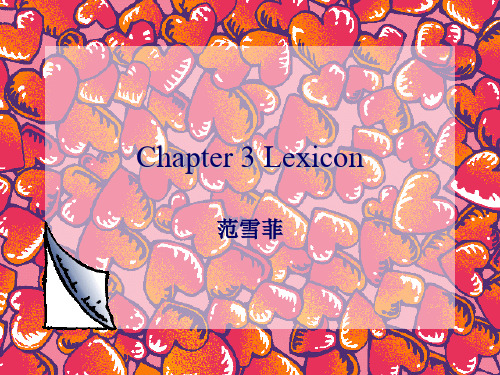
Chapter 3 Lexicon
范雪菲
3.1 What is word?
3.1.1 Three senses of “word”
*A physically definable unit (自然的有界限的单位)
• 3.1.3 classification of words
• Variable and invariable words
variable words----one could find ordered and regular series of grammatically different word forms; on the other hand, part of the word remains relatively constant. “ follow-followsfollowing”
※some of the categories newly introduced into linguistic
analysis: particles, auxiliaries, pro-form(代词形式“So
do I “), determiners
Determiners
• It refers to words which are used before the noun acting as head of a noun phrase, and determine the kind of reference the noun phrase has: definite (the) or indefinite( an ), partitive ( some ), or universal (all).
- 1、下载文档前请自行甄别文档内容的完整性,平台不提供额外的编辑、内容补充、找答案等附加服务。
- 2、"仅部分预览"的文档,不可在线预览部分如存在完整性等问题,可反馈申请退款(可完整预览的文档不适用该条件!)。
- 3、如文档侵犯您的权益,请联系客服反馈,我们会尽快为您处理(人工客服工作时间:9:00-18:30)。
Generation), hacker, email, internet,
“做秀,时装秀…” in Chinese.
Closed class words----grammatical or
functional words, such as conjunction, articles, preposition and pronouns, to which few new words can be added (e.g. the "e"as a new neutral third person singular pronoun has not been accepted).
2) Allomorphs语素(词素)变体
---any of the different form of a morpheme
语素的任何不同形式
Some morphemes have a single form in all contexts, such as “dog, bark, cat”,etc.
-ful, -er, -ish, -ness, -able, -tive, ion, etc.
Prefixes modify the meaning of the stem, but they usually do not change the part of speech of the original word.
called inflectional morphemes.
English has only several inflectional morphemes.
1) noun inflections: -s boys, boy’s The form is also used for verb 3rd-
Stem
A stem is a form to which affixes can be attached.
Thus, in this usage, the English word friendships contains the stem friend, to which the derivational suffix -ship is attached to form a new stem friendship, to which the inflectional suffix -s is attached.
friend+ -ly > friendly.
Inflection: grammatical endings, e.g plural, tense, comparative, etc. e.g
Besides the suffixes, which are used to derive words, there are other suffixes, which are added to words as markers of grammatical categories and hence
2) verb inflections: -(e)d ( past tense) wanted -en (past participle) -ing ( present participle) wanting -s (third person singular) wants
3)adjective and adverb inflections: -er (comparative) smaller, -est (superlative) smallest
The plural morpheme may be represented by:
map---maps[s] dog---dogs[z] watch---watches [iz]
The morpheme used to express indefiniteness in English has two forms:
friendship=friend(stem)+ship
friendships=friendship(stem)+s
3.5 Derivational and Inflectional morphemes
Derivation: comБайду номын сангаасination of a base and an affix to form a new word, e.g
e.g write v. --- rewrite v.
Suffixes modify the meaning of the original word and in many cases change its part of speech.
e.g help v. --- helpful adj.
3.3 Morphemes
Words are the smallest free form(unit) with meaning found in language. E.g
The boys left.
In the sentence, the plural marking -s is not a free form since it never occurs in isolation. Morpheme -- the minimal unit of meaning; the smallest meaningful elements of language.
identity, e.g. friend as in unfriendliness.
Roots may be
free: those that can stand by themselves,
e.g. black+board; nation+-al; or
bound: those that cannot stand by
3.6 Morphological rules of word formaion
--- the rules that govern the formation of words, e.g
un+ADJECTIVE = not ---ADJECTIVE unfair unthinkable unacceptable…
themselves, e.g. -ceive in receive, perceive, conceive.
Affix: the type of formative that can be used only when added to another morpheme. Normally divided into
Phoneme, morpheme and allomorph
Phoneme /p/ [p] Morpheme
{-s} plural marker of nouns Allomorphs:
[s] [z] [is]
3.4 Analyzing word structure
Root: the base form of a word that cannot be further analyzed without total loss of
prefix (dis-, un-)
---- morphemes that occur only before others,
e.g. un-, dis, anti-, ir-, etc. suffix (-en, -ify) morphemes that
occur only after others, e.g.
a building an orange;
Each of the variants is called an allomorph of a morpheme.
Here are special forms:
mouse----mice[ai] ox----oxen[n] tooth----teeth [i:]
(Exceptions: sad --- *unsad brave --- *unbrave)
3.2 Open class and closed class
Open class words---content words of a language to which we can regularly add new words, such as nouns, adjectives, verbs and adverbs,
anti+dis+establish+ment+ari+an+ism
1) Free vs. Bound morphemes:
Free morpheme: the morpheme that may constitute a word by itself (which can be a word by itself), e.g
boy, girl, table, nation.
Bound morpheme: the morpheme that cannot occur alone as a word, e.g "s" in"dogs", "al" in "national" "dis" in disclosed",
"ed" in "recorded".
word are friend and ship.
---Words are composed of morphemes. Words may consist of one morpheme or more morphemes,
